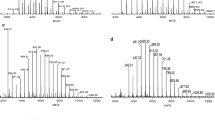Summary
In order to discuss the structure of the electrical double layer at the oil-water interface, we measured the electrocapillary curves for various inorganic electrolyte aqueous solutions (aq. phase) in contact with the oil phase containing surface active agents (oil phase). When the aqueous phase contained the potassium halide, the depression of the interfacial tension over the cathodic polarization range due to the adsorption of the surface active agent, i. e. cetyl pyridinium chloride or cytyltrimethylammonium chloride, was suppressed strongly. The suppression was larger for the anion of larger crystal radius. This phenomenon indicated that the adsorbed surface active ion was neutralised by the binding of counter-ions. When the oil phase contained sodium dodecylbenzenesulphonate, the interfacial tension was depressed over the anodic polarization region. This depression was again suppressed by the counter-ion binding. The order of this suppression for various divalent cations agreed with that of the binding ability to chondroitin sulphate. Moreover, high valent cations had strong binding ability. These counter-ion binding support the idea of the penetration of polar groups of orientated surface active agents into the aqueous phase at the oil-water interface.
Zusammenfassung
Um Aussagen über die Struktur der elektrischen Doppelschicht an Öl-Wasser-Grenzflächen zu erhalten, wurden die Elektrokapillaritätskurven von wässerigen Lösungen verschiedener anorganischer Salze in Kontakt mit der Ölphase, die grenzflächenaktive Stoffe enthielt, gemessen.
Die durch Cetylpyridiniumchlorid oder cetyltrimethylammoniumchlorid in der Ölphase bewirkte Erniedrigung der Grenzflächenspannung wurde im Bereich der kationischen Polarisation durch Kaliumhalogenide in der wässerigen Phase aufgehoben. Die Wirkung des anorganischen Salzes wurde mit zunehmendem Anionenradius stärker.
Die durch Natriumdodecylbenzolsulfonat bewirkte Erniedrigung der Grenzflächenspannung wurde durch die Kaliumhalogenide im Bereich der anodischen Polarisation aufgehoben. Die Wirkung zweiwertiger Kationen lief parallel mit der Bindungsfestigkeit dieser Ionen an Chondroitinsulfat.
Diese Ergebnisse weisen darauf hin, daß die adsorbierten grenzflächenaktiven Ionen in ihrer Wirkung durch die Bindung von Gegenionen neutralisiert werden und daß die polaren Gruppen der an der Öl-Wasser-Grenzfläche orientierten grenzflächenaktiven Molekeln in die wässerige Phase eindringen.
Similar content being viewed by others
References
Watanabe, A., M. Matsumoto, H. Tamai, andR. Gotoh, Kolloid-Z. u. Z. Polymere.
Helmholtz, H., Wiss. Abhandl. physik. techn. Reichsanstalt7, 925 (1879).
Gouy, L., J. phys. (4)9, 457 (1910); Ann. phys. (9)7, 129 (1917).
Chapman, D. L., Phil. Mag. (6)25, 475 (1913).
Stern, O., Z. Elektrochem.30, 508 (1924).
Kruyt, H. R., Colloid Science2 (Amsterdam 1949).
Klotz, I. M., The Proteins1, by Neurath and Bailey (New York 1953).
Edsall, J. T. andJ. Wyman, Biophysical Chemistry1 (New York 1958).
Ottewill, R. H. andA. Watanabe, Kolloid-Z.173, 122 (1960).
Watanabe, A., Bull. Inst. Chem. Res., Kyoto Univ.,38, 235 (1960).
Watanabe, A., M. Matsumoto, H. Tamai, andR. Gotoh, to be published.
Grahame, D. C., Chem. Revs.41, 441 (1947).
Horne, R. W., R. H. Ottewill, andA. Watanabe, Proc. IIIrd. Intern. Congr. Surface Activity1, 203 (1960).
Watanabe, A., Bull. Inst. Chem. Res., Kyoto Univ.38, 248 (1960).
Watanabe, A., ibid.38, 216 (1960).
Pauling, L., Nature of Chemical Bond (New York 1939).
Takahashi, R., Polarography, Japan13, 101 (1966).
Watanabe, A., F. Tsuji, T. Yasuda, andS. Ueda, Bull. Inst. Chem. Res., Kyoto Univ.34, 65 (1965).
Watanabe, A., F. Tsuji andS. Ueda, Proc. IInd intern. Congr. Surface Activity3, 94 (1957).
Author information
Authors and Affiliations
Additional information
With 7 figures and 1 table
Rights and permissions
About this article
Cite this article
Watanabe, A., Matsumoto, M., Gotoh, R. et al. Electrocapillary phenomena at oil-water interfaces. Kolloid-Z.u.Z.Polymere 221, 47–52 (1967). https://doi.org/10.1007/BF02091923
Received:
Issue Date:
DOI: https://doi.org/10.1007/BF02091923




